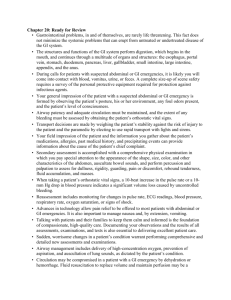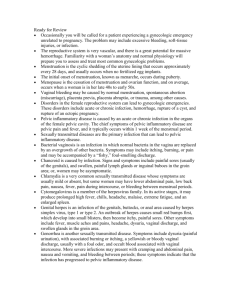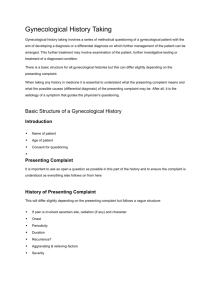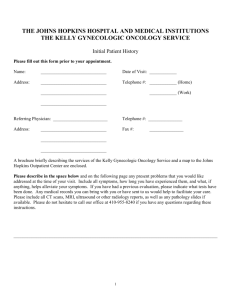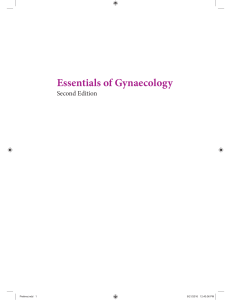Chapter 25 Gynecological Emergencies 25-1
advertisement
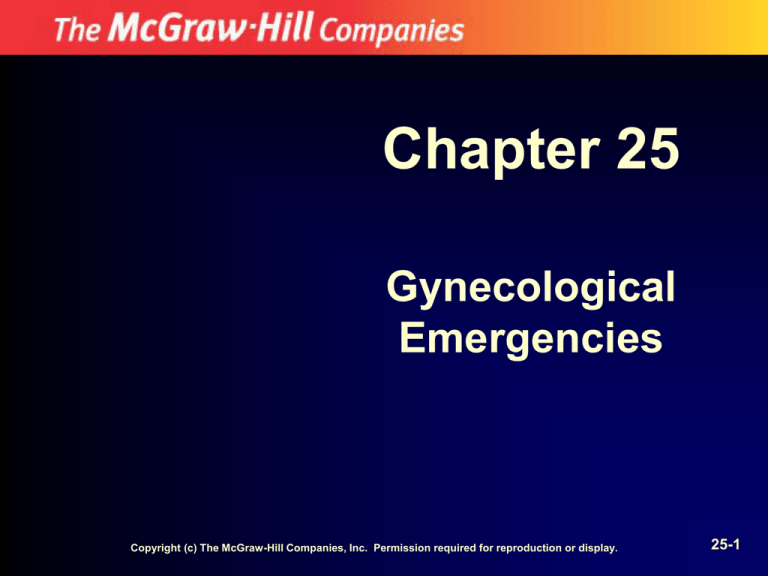
Chapter 25 Gynecological Emergencies Copyright (c) The McGraw-Hill Companies, Inc. Permission required for reproduction or display. 25-1 Objectives 25-2 Review of the Female Reproductive System 25-3 Female Anatomy and Physiology 25-4 Female Anatomy and Physiology • Vagina – Birth canal • Perineum – Area between vaginal opening and anus 25-5 Assessment of the Gynecological Patient 25-6 Gynecological Emergencies • SAMPLE history 25-7 Gynecological Emergencies • Common assessment findings and symptoms – Abdominal pain – Abdominal tenderness – Vaginal discharge – Abnormal vaginal bleeding – Fever, chills – Sweating – Increased heart rate – Nausea, vomiting – Pain during intercourse – Pain that worsens with coughing or urination – Fainting 25-8 Physical Examination • Be certain to explain what you are about to do and why it must be done. • Remember to properly drape or shield an unclothed patient from the stares of others. • Conduct the examination professionally and efficiently. • Talk with your patient throughout the procedure. 25-9 Physical Examination • Do not visually inspect the vaginal area unless major bleeding is present or you anticipate that childbirth is about to occur. • Have another healthcare professional or law enforcement officer present. • If possible, include a female attendant or rescuer in your examination. 25-10 Emergency Care • Standard precautions • Give oxygen • Treat for shock, if indicated • Keep patient warm • Apply external sanitary napkins as necessary – Take blood-soaked garments and pads with patient to hospital 25-11 Nontraumatic Gynecological Emergencies 25-12 Pelvic Inflammatory Disease (PID) • Infection of the uterus, fallopian tubes, and other female reproductive organs • Usually caused by sexually transmitted bacteria • If untreated, can lead to septic shock and infertility 25-13 Pelvic Inflammatory Disease • Assessment findings and symptoms – Lower abdominal pain – Fever – Vaginal discharge – Painful intercourse – Painful urination – Increased heart rate – Normal or slightly elevated blood pressure 25-14 Pelvic Inflammatory Disease • Allow the patient to assume a position of comfort. • Document any vaginal discharge including the color, odor, and amount. • Transport for physician evaluation. • Reassess as often as indicated. • Record all patient care information on a prehospital care report. 25-15 Ectopic Pregnancy [Insert figure 25-6] 25-16 Ectopic Pregnancy • If rupture occurs: – Patient may experience sudden, severe pain on one side of the lower abdomen – Vaginal bleeding may or may not be present – Patient may feel faint or actually faint – Patient may complain of severe pain in the back of the shoulder (referred pain) – Patient may have severe internal bleeding – Patient may exhibit signs of shock 25-17 Emergency Care • Medical emergency! • • • • • • Prepare for immediate transport Keep on scene time to a minimum Give oxygen by nonrebreather mask Assess and treat for shock Keep the patient warm Provide emotional support for the patient and family 25-18 Ovarian Cyst • A fluid-filled sac that develops on or within an ovary • The most common type of ovarian cyst forms during the menstrual cycle 25-19 Ovarian Cyst • Assessment findings and symptoms – Lower abdominal or pelvic pain – Irregular menstrual periods – Dull ache in the lower back and thighs – Faintness, dizziness, or weakness – Lower abdominal or pelvic pressure or fullness – Pelvic pain after strenuous exercise or sexual intercourse – Weight gain – Pain or pressure with urination or bowel movements – Difficulty passing urine completely – Nausea and vomiting 25-20 Ovarian Cyst • Provide supportive care • Allow the patient to assume a position of comfort. • Transport for physician evaluation. • Reassess as often as indicated. • Record all patient care information on a prehospital care report. 25-21 Traumatic Gynecological Emergencies 25-22 Traumatic Gynecological Emergencies • Possible causes – Bicycle injuries – Blows – Foreign body insertion – Childbirth lacerations – Sexual assault 25-23 Traumatic Gynecological Emergencies • Standard precautions • Give oxygen • Control bleeding with local pressure to area • Treat for shock, if indicated • Provide reassurance and privacy 25-24 Apparent Sexual Assault • Standard precautions • When possible, ask EMT of same gender to assess patient • Maintain nonjudgmental attitude • Protect crime scene • Careful documentation • Discourage patient from bathing, etc. • Bag patient’s clothing separately in paper (not plastic) bags 25-25 Questions? 25-26

